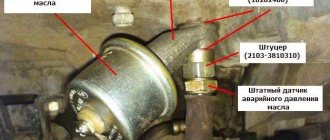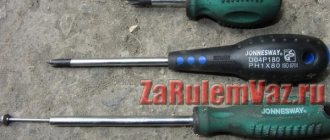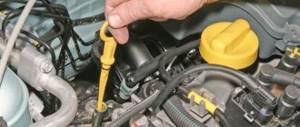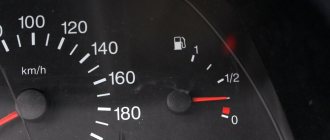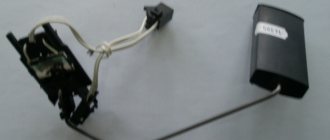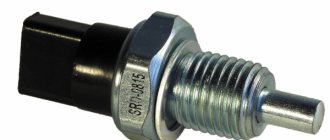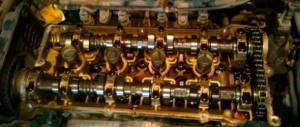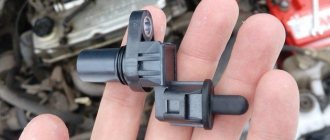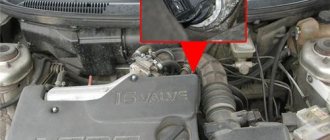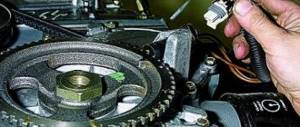The operating principle of the oil level sensor (OLS) and its location in the lubrication system
With the development of automobiles, the need to check the oil level with a dipstick before each trip has disappeared. On modern cars, the oil level sensor is responsible for this. The dipstick is still included in the design, but now it is used to fill the engine with oil. In a lubrication system, the oil sensor is usually located next to the oil filter.
Oil level sensors on passenger cars come in several types, including thermal, ultrasonic and float. Each of them will be discussed in more detail in the following paragraphs of the article.
The simplest of the oil sensors is mechanical, and it is also the one most often used on cars. The principle of operation of any float-type sensors (magnetic, mechanical and others) is to open and close the corresponding switch; in some cases, direct contact with a magnetic mechanism or switch is allowed. Such sensors are usually not used for high viscosity oils.
In the case of a thermal sensor, the measuring element becomes a wire that is heated during operation. The ultrasonic sensor evaluates the required indicators using ultrasonic pulses reflected from the oil surface.
Checking the oil level sensor
There are situations when the device readings are suspicious. In such cases, you need to know how to check the oil level sensor and what to look for. To carry out diagnostics, do the following:
If there is no voltage, there are three possible reasons: failure of the display unit, poor contact quality, or broken wire in the sensor circuits. Are the wiring and contact quality in good condition? – Then the cause of all problems is DUM.
Components of the DUM
The components of the oil sensor depend on its type and design. Float type sensors have a magnet that moves along a vertical tube to determine the oil level in the system.
Thermal sensors may include a wire and a temperature sensor, and electrothermal devices, which are a type of thermal device, use a high-resistance wire that is heated by current.
Ultrasonic sensors contain an electronic measuring unit that is responsible for taking readings and transmitting data to the dashboard.
Sensor types:
- Float type DUM
Float-type oil sensors are simpler in design than all others. They consist of a float that moves along a vertical pipe. There is a magnet in the float, and a magnet-controlled contact is located in the pipe. This contact is activated when a magnet approaches it. When the contact is activated, the oil level in the vehicle's engine is low. The contact closes the control circuit. It generates a signal that transmits a warning to the dashboard. Such a sensor can only operate at a fixed point; this factor limits its use on passenger cars. - Thermal DUM
- Electrothermal DUM
- Ultrasonic DUM and graphical oil level indication
- Oil level and condition sensor
One of the most common at the moment is the thermal oil sensor. A special wire is used as its sensitive element. The principle of operation of the device is to briefly heat the wire to maximum temperature and then lower it to oil temperature. In this case, the oil level in the system can be calculated based on the time spent cooling the wire. The faster the cooling occurs, the more oil there is, and vice versa.
In some cases, not only the oil level is measured, but also its temperature; this requires an additional temperature sensor. It is installed in the same housing with the oil sensor and signals from each of them are transmitted to the car’s dashboard.
An electrothermal oil sensor is a type of thermal sensor. The main difference is the use of wire with a high degree of temperature resistance. The wire heats up as current passes through it, and the overall resistance is determined by how much of the wire is immersed in oil. The lower the resistance, the greater the immersion of the wire, and vice versa. Thus, the oil level is determined by electrothermal sensors based on voltage readings.
Ultrasonic sensors allow non-contact measurement of oil level, regardless of its quality and viscosity. The sensor emits high-frequency waves that are reflected back to the measuring element to take a reading.
The measurement result can be influenced by vibrations, evaporation, foam, and changes in oil concentration. Vibrations and foam will partially prevent the sound wave generated and the data on the sensor may be distorted. In the presence of chemical vapors or condensation, the sound wave may also be absorbed. Changes in the concentration of a substance can cause a change in the amount of ultrasonic wave energy, which will also affect the sensor readings.
Proper installation of the transducer is necessary to ensure adequate response to reflected sound. The place where it is attached must be cleared of any obstacles. These include various welded structures, etc.
Ultrasonic sensors allow for graphical indication of the oil level in the system if there are corresponding indicators on the dashboard.
Recently, ultrasonic sensors have been in demand due to their favorable combination of functionality and price.
Oil level and condition sensors are used on BMW cars. Such sensors allow monitoring not only the oil level, but also its condition.
The design of such devices can be considered using the example of a capacitive-type sensor. It includes a pair of vertical capacitors. The role of electrodes is played by two metal tubes, one of which is located inside the other. The dielectric function is performed by the motor oil located between the electrodes. The upper capacitor is responsible for measuring the oil level, and the lower one for its condition.
When the oil level decreases, the capacitance of the upper capacitor changes, which is converted into a digital signal and transmitted to the engine control unit. During vehicle operation, the properties of the oil used, such as dielectric constant or viscosity, may change. As a result of these changes, the capacitance of the lower capacitor also changes. The oil temperature is measured using a temperature sensor built into the electronic unit. In this case, the oil temperature, its quality and level are measured continuously after the engine is started.
With the help of an oil level and condition sensor, it becomes possible to operate the vehicle according to its real condition, and not based on mileage, as in many modern cars. This approach allows you to use oil more efficiently and reduce operating costs.
Diagnostics of oil level sensor operation and troubleshooting
When detecting malfunctions, you should first determine whether the lamp on the dashboard, which is responsible for the sensor readings, is active. After this, you need to find and determine the cause of the problems; the most common ones include low oil level, incorrect connection of devices or malfunction of the engine.
To diagnose the oil sensor, place the car in an inspection hole and remove the protection. Once the sensor is found, you can turn on the ignition and disconnect the wire from the sensor. Using a voltmeter, the voltage between the so-called “ground” and the connecting block is measured. Normally, this indicator is around 12V.
If there is no voltage, faults such as a broken wire or poor contact in the circuit are possible, and a malfunction of the display unit cannot be ruled out.
Operating principle of the oil level sensor
The sensor itself is a simple device, the principle of which is based on measuring resistance. During operation, the device is immersed in engine oil (the resistance indicator is maximum). If there is an oil leak and its level decreases, the current resistance decreases and a corresponding signal is sent to the instrument panel.
The command for the lamp to ignite is given by the VAZ 2110 oil level sensor. It is this that monitors the level of lubricating fluid and promptly warns the driver about the problem - a decrease in the oil level.
But there are situations when the device fails and sends false information to the panel. In this case, you need to know where the oil level sensor is located and how to check and replace it.
The DUM indicator can light up for two reasons:
- The oil level has dropped below a critical level.
- The device itself has failed or the contact group has oxidized.
Repair and complete replacement of the oil sensor with your own hands or at a car dealership
Replacing the sensor yourself is quite possible and will save on the work of a car service specialist.
In general, the oil sensor is located to the left of the engine in foreign cars or directly in the crankcase, like in domestic cars, although there are more complex designs.
To replace the sensor yourself, you should place the car in an inspection hole and turn off the ignition and engine ground. Then you need to remove the pan and find the sensor to disconnect all the wires from it. Using a socket wrench “10”, the device mount is unscrewed. After this, it can be removed and replaced with a new one by performing all the same steps in reverse order.
The cost of a new oil level sensor in Russia and the CIS countries
The average cost of a new oil level sensor in Russia is from 500 rubles, and replacing it will cost several times more. Even checking the device by a car service specialist costs a certain amount, although it can be done independently. To do this, you should analyze the operation of the device at various distances. If the readings vary greatly, it may be faulty or incorrectly installed.
Oil sensors are sold in almost any car store. You can also try to buy it on the car market at a reduced price, but in this case the purchase of a serviceable sensor suitable for a particular car is usually not guaranteed.
How does the oil level sensor work in a car?
Can anyone still be surprised by the fact that some cars do not have a dipstick to check the amount of oil in the engine? On such cars, the role of the dipstick is played by the oil level sensor. Let's consider the device, the principle of operation of the system, where the sensor is located and why it lights up if the level and temperature of the engine oil are normal.
Classification of level gauges according to operating principle:
- float sensor;
- thermal;
- electrothermal;
- ultrasonic.
